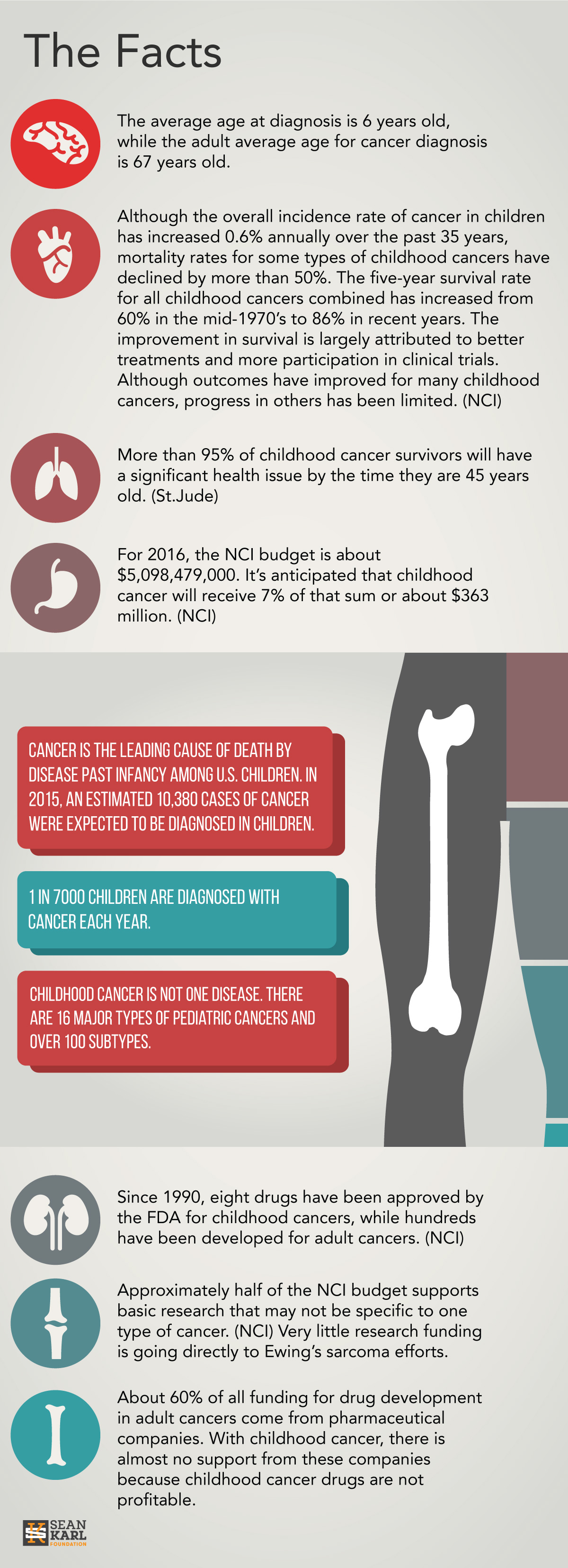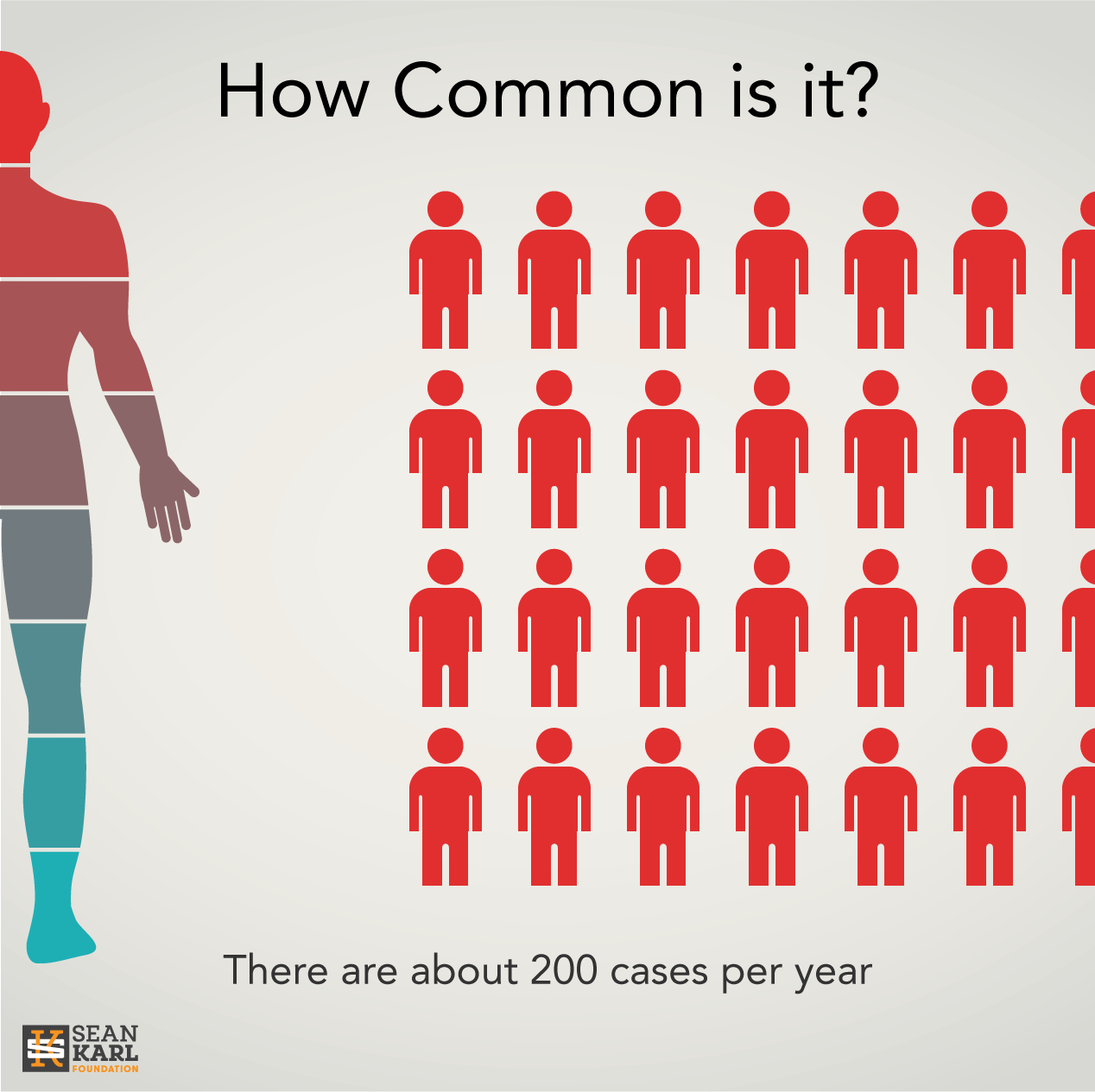Facts About Pediatric Cancer & Ewing Sarcoma
Facts About Childhood Cancers

- Cancer is the leading cause of death by disease past infancy among U.S. children. In 2015, an estimated 10,380 cases of cancer were expected to be diagnosed in children ages 1 to 14 years. (National Cancer Institute)
- 1 in 7,000 children will be diagnosed with pediatric cancer each year. (National Cancer Institute)
- The average age at diagnosis is 6 years old, while the adult average age for cancer diagnosis is 67 years old. (National Cancer Institute)
- Childhood cancer is not one disease. There are 16 major types of pediatric cancers and over 100 subtypes. (American Cancer Society)
- Although the overall incidence rate of cancer in children has increased 0.6% annually over the past 35 years, mortality rates for some types of childhood cancers have declined by more than 50%. The five-year survival rate for all childhood cancers combined has increased from 60% in the mid-1970’s to 86% in recent years. The improvement in survival is largely attributed to better treatments and more participation in clinical trials. Although outcomes have improved for many childhood cancers, progress in others has been limited. (National Cancer Institute)
- More than 95% of childhood cancer survivors will have a significant health issue by the time they are 45 years old. (St. Jude)
Funding & Research
- For 2016, the NCI budget is about $5,098,479,000. It’s anticipated that childhood cancer will receive 7% of that sum or about $363 million. (National Cancer Institute)
- Since 1990, eight drugs have been approved by the FDA for childhood cancers, while hundreds have been developed for adult cancers. (National Cancer Institute)
- Approximately half of the NCI budget supports basic research that may not be specific to one type of cancer. (National Cancer Institute)
- Very little research funding is going directly to Ewing Sarcoma efforts
- About 60% of all funding for drug development in adult cancers come from pharmaceutical companies. With childhood cancer, there is almost no support from these companies because childhood cancer drugs are not profitable.
What is Ewing Sarcoma?
Ewing Sarcoma is a primary bone cancer. This means the cancer originates in bone cells. But that doesn’t mean it is exclusive to bone cells, because it can also start in cells outside of the bone, in soft issue. When this is the case, it’s called extraosseous Ewing Sarcoma. Ewing tumors are usually found in the long bones — the legs, pelvis, ribs, arms or spine — and can spread to the lungs, bones and bone marrow.
How Common is Ewing Sarcoma?
Though Ewing Sarcoma is the second most common type of bone cancer in children and young adults, it’s still considered very rare. In the United States, roughly 200 children and young adults are diagnosed with Ewing Sarcoma each year.
About half of all Ewing Sarcoma tumors occur in children and young adults between the ages of 10 and 20, and it affects slightly more boys than girls. This type of cancer doesn’t appear to be hereditary.
Ewing Sarcoma Symptoms

Symptoms of Ewing Sarcoma can vary in intensity and frequency, but most of the common symptoms include:
- Swelling and soreness around the tumor area, which is commonly mistaken for a sports injury or bumps and bruises that every child gets
- A low fever that, at first, may seem to be caused by an infection
- Bone pain, especially pain that worsens during exercise or at night
- Limping, which is caused by a tumor on a leg bone
Treatment
Ewing Sarcoma Survival Rates

About 70% of children with nonmetastatic Ewing Sarcoma survive. The survival rate for children diagnosed after their disease has spread is less than 24%. Children whose tumors are larger or located in the pelvis, ribs or spine are less likely to survive.
As a child ages, the survival rate decreases. Teens aged 15–19 have a lower survival rate — roughly 56%.





